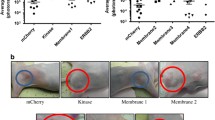Abstract
A number of approaches have been used to identify genes important in breast cancer. In one approach the genes already shown to be involved in other tumors, such as p53 and Her2neu, were examined. A second approach examined genes detected through genetic screening of families with a high incidence of breast cancer, for example, BRCA-1 and BRCA-2. We used a third approach, subtractive hybridization, to identify and clone genes that were preferentially expressed in breast cancer cells compared to normal mammary epithelium. Instead of analyzing breast cancer cell lines, we examined fresh human breast cancer specimens. By subtracting normal mammary epithelial cDNA from breast cancer cDNA, we were able to clone several genes overexpressed in breast cancer. Two of these genes, L19 and MLN70, were previously reported to be overexpressed in breast cancer. Three of these genes, L19, L34, and MLN70, were localized to a region on chromosome 17 where Her2/neu and BRCA-1 are found. In addition, we isolated a gene we call breast cancer associated gene-1 that was expressed almost exclusively in fresh breast cancer tissue and not in normal mammary epithelium or breast cancer cell lines. We were unable to detect expression of breast cancer associated gene-1 in cell lines from melanoma, renal cell carcinoma, lymphoma, or leukemia. The full-length sequence from two separate breast cancer specimens revealed one amino acid difference compared to the sequence from normal breast epithelial tissue. Further studies are necessary to determine whether these genes contribute to breast cancer development or can be used as therapeutic targets.
Similar content being viewed by others
References
Kirsh DG, Kastan MB: Tumor-suppressor p53: implications for tumor development and prognosis. J Clin Oncol 16: 3158-3168, 1998
Lee S, Elenbaas B, Levine A, Griffith J: p53 and its 14 KDa Cterminal domain recognize primary DNA damage in the form of insertion/deletion mismatches. Cell 81: 1013-1020, 1995
Schechter AL, Stern DF, Vaidyanathan LV, Decker SJ, Drebin JA, Greene MI, Weinberg RA: The neu oncogene: an erb-Brelated gene encoding a 185,000-Mr tumor antigen. Nature 312: 513-516, 1984
Guy CT, Webster MA, Schaller M, Parsons TJ, Carn RD, Muller WJ: Expression of the neu protooncogene in the mammary epithelium of transgenic mice induces metastatic disease. Proc Natl Acad Sci 89: 10578-10582, 1992
Slamon DJ, Clark GM, Wong SG, Levin WJ, Ullrich A, McGuire WL: Human breast cancer: correlation relapse and survival with amplification of the HER-2/neu oncogene. Science 235: 177-182, 1987
Feunteun J: Breast cancer and genetic instability: to molecules behind the scenes. Mol Med Today June: 263-267, 1998
Ace CI, Balsamo M, Le LT, Okulicz WC: Isolation of progesterone-dependent complementarity deoxyribonucleic acid fragment from rhesus monkey endometrium by sequentail subtractive hybridization and poymerase chain reaction amplification. Endocrinol 134: 1305-1309, 1994
Davies B, Fried M: The L19 ribosomal protein gene (RPL19): gene organization, chromosome mapping, and novel promoter region. Genomics 20: 372-380, 1995
Rommens JM, Durocher F, McArthur J, Tonin P, LeBlanc J, Allen T, Samson C, Ferri L, Narod S, Morgan K, Simard J: Generation of a transcriptional map at the HSD17B locus centromeric to BRCA1 at 17q21. Genomics 28: 530-542, 1995
Tomasetto C, Regnier C, Moog-Lutz C, Mattei MG, Chenard MP, Lidereau R, Basset P, Rio MC: Identification of four novel human genes amplified and overexpressed in breast carcinoma and localized to the q11-q21.3 region of chromosome 17. Genomics 28: 367-376, 1995
Henry JL, Coggin DL, King CR: High-level of the ribosomal protein L19 in human breast tumors that overexpress erbB-2. Cancer Res 53: 1403-1408, 1993
Tanaka M, Adzuma K, Iwama M, Yoshimoto K, Monden Y, Itakura M: Human calgizzarin; one colorectal cancerrelated gene selected by a large scale random cDNA sequencing and Northern blot analysis. Cancer Lett 89: 195-200, 1995
Direct submission to GenBank, accession #Z23090
Direct submission to GenBank, accession #U35139
Maruyama K, Usami M, Aizawa T, Yoshikawa K: A novel brain-specific mRNA encoding nuclear protein (necdin) expressed in neurally differentiated embryonal carcinoma cells. Biochem Biophys Res Commun 178: 291-296, 1991
Hayashi Y, Matsuyama K, Takagi K, Sugiura H, Yoshikawa K: Arrest of cell growth by necdin, a nuclear protein expressed in postmitotic neurons. Biochem Biophys Res Commun 213: 317-324, 1995
Taniura H, Taniguchi N, Hara M, Yoshikawa K: Necdin, a postmitotic neuron-specific growth suppressor, interacts with viral transforming proteins and cellular transcriptional factor E2F1. J Biol Chem 272: 720-728, 1998
Taniura H, Matsumoto K, Yoshikawa K: Physical and functional interactions of neuronal growth suppressor necdin with p53. J Biol Chem 274: 16242-16248, 1999
Van den Eynde BJ, Boon T: Tumor antigens recognized by T lymphocytes. Int J Clin Lab Res 27: 81-86, 1997
Author information
Authors and Affiliations
Rights and permissions
About this article
Cite this article
Kurt, R.A., Urba, W.J. & Schoof, D.D. Isolation of genes overexpressed in freshly isolated breast cancer specimens. Breast Cancer Res Treat 59, 41–48 (2000). https://doi.org/10.1023/A:1006315919985
Issue Date:
DOI: https://doi.org/10.1023/A:1006315919985




